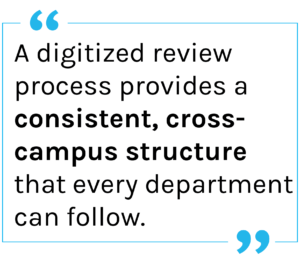Performance management is more than just a yearly review – it’s a retention technique and a chance to encourage growth among your staff and faculty.
Performance management is often thought of as the annual review process: when employees check in with their managers or leadership to make sure they’re on track with their job duties, goals, or professional development. But performance management can be so much more than that – a good performance management program can keep employees feeling engaged, encouraging growth and increasing retention. So how can you build out your performance management program to have a real impact on your campus? Check out some of our tips below.
Don’t limit communication and feedback
Annual performance reviews are not as effective as frequent, continuous feedback. While the amount and timing of feedback necessary might vary by department or by college across campus, it’s important that you enable managers and leadership to document feedback throughout the year and empower regular conversations or check-ins with their employees.
Digitize!
 A digitized performance management system goes a long way towards supporting the goal of frequent communication—and it checks a lot of other boxes too. First, it keeps everything in one place, meaning that both managers and employees can go back and see what has previously been noted or discussed. Second, it can automate communication and reminders, so everyone completes required tasks when they’re due, without intervention from HR. Third, a digitized review process provides consistent, cross-campus structure that every department can follow. Even if different roles require different evaluation types, a standardized process ensures that employees receive actionable feedback and that reviews are fair and defensible. When different areas of campus are left to design their own systems from scratch, you might leave room for bias or end up with too many general, open-ended questions that don’t relate to job duties or performance. A solution like PeopleAdmin’s Performance Management offers the standardized yet customizable solution that fits the needs of a HigherEd campus.
A digitized performance management system goes a long way towards supporting the goal of frequent communication—and it checks a lot of other boxes too. First, it keeps everything in one place, meaning that both managers and employees can go back and see what has previously been noted or discussed. Second, it can automate communication and reminders, so everyone completes required tasks when they’re due, without intervention from HR. Third, a digitized review process provides consistent, cross-campus structure that every department can follow. Even if different roles require different evaluation types, a standardized process ensures that employees receive actionable feedback and that reviews are fair and defensible. When different areas of campus are left to design their own systems from scratch, you might leave room for bias or end up with too many general, open-ended questions that don’t relate to job duties or performance. A solution like PeopleAdmin’s Performance Management offers the standardized yet customizable solution that fits the needs of a HigherEd campus.
Create a culture of growth
Performance management processes should encompass professional development and career growth. Colleges and universities are struggling with retention and attracting talent—and some of that might be because of the lack (or perceived lack) of career growth opportunities. Most under 25-year-olds have a poor perception of higher education work culture, and the Chronicle of Higher Education noted that professional development opportunities are a vital tool in creating a positive work culture at your college or university. If you’re hoping to attract new talent and to keep the talent you have, build professional development goals and career growth metrics into your performance management process. Focus on engagement and long-term opportunities so that your faculty and staff know you’re invested.
Final thoughts
Don’t rely on the way performance management has always been done at your institution. There is new research on employee growth and engagement coming out all the time, and job-seekers today place a high value on feeling like their employer is invested in them. Take the time to build a performance management (and professional development) program that works for your institution.